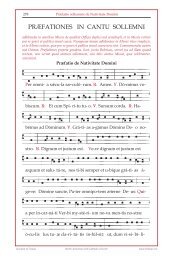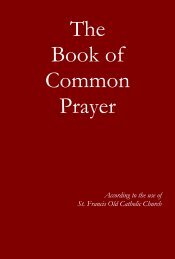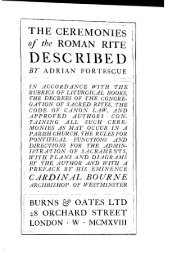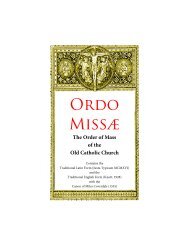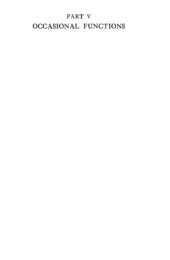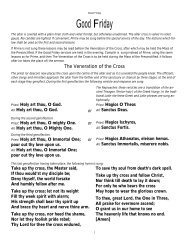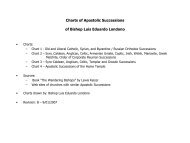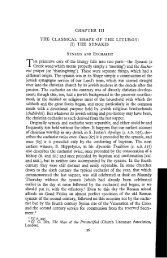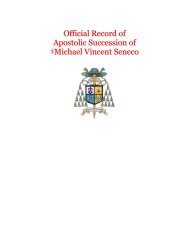Eucharist and Lord's Supper
Eucharist and Lord's Supper
Eucharist and Lord's Supper
You also want an ePaper? Increase the reach of your titles
YUMPU automatically turns print PDFs into web optimized ePapers that Google loves.
EUCHARIST AND LORD'S SUPPER 81<br />
immediately after it had been blessed. So in the liturgical 'four-action'<br />
shape of the rite, it is broken at once after the blessing (by the eucharistia,<br />
along with the wine) for communion which follows immediately. But<br />
though there is nothing in the record of the last supper to suggest that our<br />
Lord made any point of the broken bread representing His own Body<br />
'broken' on the cross (<strong>and</strong> in fact the fourth gospel makes a strong point of<br />
the fact that His Body was not broken? the symbolism was bound to<br />
suggest itself to somebody. The reading 'This is My Bodywhich is broken<br />
(klomenon) for you' in I Cor. xi. 24, adopted by the A.V. alongside the<br />
other (more strongly attested) ancient interpolation 'given for you', is the<br />
proof that this symbolism of the fraction as representing the passion was<br />
explicitly adopted in some quarters in the second century.<br />
(4) The communion. It appears to have been the universal tradition in<br />
the pre-Nicene church that all should receive communion st<strong>and</strong>ing. This<br />
was the posture in which the cup of blessing was received at the chaburah<br />
meal, though the broken bread was received sitting or reclining at table.<br />
Presumably the change in posture for receiving the bread was made when<br />
the meal was separated from the eucharist. The jews stood for the recitation<br />
of the berakah<strong>and</strong> to receive the cup of blessing, <strong>and</strong> this affected the<br />
bread, too, when its distribution came to be placed between the end of the<br />
berakah <strong>and</strong> the h<strong>and</strong>ing of the cup.<br />
Communion ended the rite, just as the h<strong>and</strong>ing of the cup was the last<br />
of those points in the chaburah meeting to which our Lord had attached<br />
a special meaning. The psalm which ended the chabUrah meal therefore<br />
reappears at the agape, not at the eucharist. There was thus no 'than..1{sgiving'<br />
at the end of the primitive eucharist. The berakah was itself a<br />
'Thanksgiving' <strong>and</strong> this was the meaning of eucharistia also. The idea of a<br />
corporate 'thanksgiving for the Thanksgiving' could only come to appear<br />
reasonable after the church had lost all contact with the jewish origins of<br />
the rite. Even then the tradition was for centuries too strong to be set aside<br />
that the bsrakah or eucharistia was the only prayer in the rite, which must<br />
express in words its whole meaning-from the offertory to the communion.<br />
It is only in the iourtb~.ertWry that a ~rateiliaillssgi.ying after communion<br />
begins to make its appearance in eucharistic rites in Syria <strong>and</strong><br />
Egypt; <strong>and</strong> even then in the great historic rites it always remains a very<br />
brief <strong>and</strong> formal little section, appended, as it were, to the eucharistic<br />
action, which really ends at its climax, the communion. A single sentence<br />
of dismissal, probably said by the deacon, appears to have been the only<br />
thing that followed the communion in the pre-Nicene church. Here again<br />
the influence of its origin appears to have marked the Shape of the Liturgy<br />
permanently throughout christendom, down to the sixteenth century.<br />
Such was the structure of the pre-Nicene eucharist in its 'four-action<br />
shape', the bare elements of those parts of the chabllrah rite to which our<br />
1 John xix. }'i.



